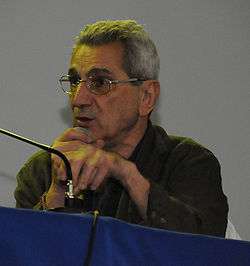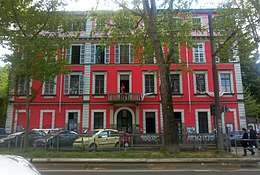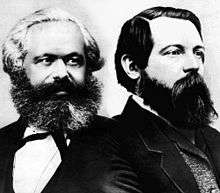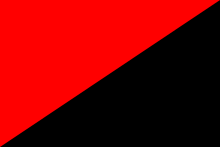Autonomism
Autonomism, also known as autonomist Marxism or autonomous Marxism, is a set of anti-authoritarian left-wing political and social movements and theories.[1][2][3] As a theoretical system, it first emerged in Italy in the 1960s from workerist (operaismo) communism. Later, post-Marxist and anarchist tendencies became significant after influence from the Situationists, the failure of Italian far-left movements in the 1970s, and the emergence of a number of important theorists including Antonio Negri, who had contributed to the 1969 founding of Potere Operaio, as well as Mario Tronti, Paolo Virno and Franco "Bifo" Berardi.
Georgy Katsiaficas summarizes the forms of autonomous movements saying that "In contrast to the centralized decisions and hierarchical authority structures of modern institutions, autonomous social movements involve people directly in decisions affecting their everyday lives. They seek to expand democracy and to help individuals break free of political structures and behavior patterns imposed from the outside".[4] As such this has involved a call for the independence of social movements from political parties[5] in a revolutionary perspective which seeks to create a practical political alternative to both authoritarian/state socialism and contemporary representative democracy.[6]
Autonomism influenced the German and Dutch Autonomen, the worldwide social centre movement, and today is influential in Italy, France, and to a lesser extent the English-speaking countries. Those who describe themselves as autonomists now vary from Marxists to anarchists.[7]
Etymology
The term autonomia / Autonome is composed out of two Greek words: αὐτο- auto- "self" and νόμος nomos, "law", hence when combined understood to mean "one who gives oneself one's own law". Autonomy, in this sense, is not independence. While independence refers to an autarchic kind of life, separated from the community, autonomy refers to life in society but by one's own rule. Though the notion of autonomism was alien to the ancient Greeks, the concept is indirectly endorsed by Aristotle, who stated that only beasts or gods could be independent and live apart from the polis ("community"), while Kant defined the Enlightenment by autonomy of thought and the famous "Sapere aude" ("dare to know").
The Marxist Autonomist theory
| Part of a series on |
| Left communism |
|---|
 |
|
Concepts |
|
Organizations
|
|
Related topics
|
|
Unlike other forms of Marxism, Autonomist Marxism emphasises the ability of the working class to force changes to the organization of the capitalist system independent of the state, trade unions or political parties. Autonomists are less concerned with party political organization than other Marxists, focusing instead on self-organized action outside of traditional organizational structures. Autonomist Marxism is thus a "bottom-up" theory: it draws attention to activities that autonomists see as everyday working-class resistance to capitalism, such as absenteeism, slow working, socialization in the workplace, sabotage, and other subversive activities.
Like other Marxists, autonomists see class struggle as being of central importance. However, autonomists have a broader definition of the working class than do other Marxists: as well as wage-earning workers (both white collar and blue collar), autonomists also include in this category the unwaged (students, the unemployed, homemakers, etc.), who are traditionally deprived of any form of union representation.
Early theorists (such as Mario Tronti, Antonio Negri, Sergio Bologna, and Paolo Virno) developed notions of "immaterial" and "social labour" that extended the Marxist concept of labour to all society. They suggested that modern society's wealth was produced by unaccountable collective work, and that only a little of this was redistributed to the workers in the form of wages. Other Italian autonomists—particularly feminists, such as Mariarosa Dalla Costa and Silvia Federici—emphasised the importance of feminism and the value of unpaid female labour to capitalist society.
A scholar of the movement, Michael Ryan, writes that
Autonomy, as a movement and as a theory, opposes the notion that capitalism is an irrational system which can be made rational through planning. Instead, it assumes the workers' viewpoint, privileging their activity as the lever of revolutionary passage as that which alone can construct a communist society. Economics is seen as being entirely political; economic relations are direct political relations of force between class subjects. And it is in the economic category of the social worker, not in an alienated political form like the party, that the initiative for political change resides.[8]
Italian autonomism

Autonomist Marxism—referred to in Italy as operaismo, which translates literally as "workerism"—first appeared in Italy in the early 1960s. Arguably, the emergence of early autonomism can be traced to the dissatisfaction of automotive workers in Turin with their union, which reached an agreement with FIAT. The disillusionment of these workers with their organised representation, along with the resultant riots (in particular the 1962 riots by FIAT workers in Turin, "fatti di Piazza Statuto"), were critical factors in the development of a theory of self-organised labour representation outside the scope of traditional representatives such as trade unions.
In 1969, the operaismo approach was active mainly in two different groups: Lotta Continua, led by Adriano Sofri (which had a very significant Roman Catholic cultural matrix), and Potere Operaio, led by Antonio Negri, Franco Piperno, Oreste Scalzone, and Valerio Morucci. Mario Capanna was the charismatic leader of the Milan student movement, which had a more classical Marxist-Leninist approach.
Influences
Through translations made available by Danilo Montaldi and others, the Italian autonomists drew upon previous activist research in the United States by the Johnson–Forest Tendency and in France by the group Socialisme ou Barbarie. The Johnson-Forest Tendency had studied working-class life and struggles within the US auto industry, publishing pamphlets such as "The American Worker" (1947), "Punching Out" (1952), and "Union Committeemen and Wildcat Strikes" (1955). That work was translated into French by Socialisme ou Barbarie and published, serially, in their journal. They too began investigating and writing about what was going on inside workplaces, in their case inside both auto factories and insurance offices.
The journal Quaderni Rossi ("Red Notebooks"), produced between 1961 and 1965, and its successor Classe Operaia ("Working Class"), produced between 1963 and 1966, were also influential in the development of early autonomism. Raniero Panzieri, Mario Tronti, and Toni Negri were some primary collaborators.
Pirate radio stations also were a factor in spreading autonomist ideas. Bologna's Radio Alice was an example of such a station.
Direct action

The Italian student movement, including the Indiani Metropolitani (Metropolitan Indians), starting from 1966 with the murder of student Paolo Rossi by neo-fascists at Rome University, engaged in various direct action operations, including riots and occupations, along with more peaceful activities such as self-reduction, in which individuals refused to pay for such services and goods as public transport, electricity, gas, rent, and food. Several clashes occurred between students and the police during the occupations of universities in the winter of 1967–68, during the Fiat occupations, and in March 1968 in Rome during the Battle of Valle Giulia.
Indiani Metropolitani were a small faction active in the Italian far-left protest movement during 1976 and 1977, in the so-called "Years of Lead". The Indiani Metropolitani were the so-called 'creative' wing of the movement. Its adherents wore face-paint like the war-paint of Native Americans and dressed like hippies. The emphasis was on "stare insieme" (being together), spontaneity and the arts, especially music. The group was active in Rome, during the occupation of the university La Sapienza in 1977.
On 11 March 1977, riots took place in Bologna following the killing of student Francesco Lorusso by police.
Beginning in 1979, the state effectively prosecuted the autonomist movement, accusing it of protecting the Red Brigades, which had kidnapped and assassinated Aldo Moro. 12,000 far-left activists were detained; 600 fled the country, including 300 to France and 200 to South America.[9]

Tute Bianche was a militant Italian social movement, active from 1994 to 2001. Activists covered their bodies with padding so as to resist the blows of police, to push through police lines, and to march together in large blocks for mutual protection during demonstrations. The tute bianche movement reached its apex during the anti-G8 protests in Genoa, in July 2001, with a turn-out of an estimated 10,000 protesters in a single "padded block", ironically after a collective decision to go without the white overalls. Shortly after Genoa the Ya Basta Association disbanded, with certain segments reforming into the "Disobbedienti" which literally means "Disobedients". This philosophy includes the occupation and creation of squatted self-managed social centers, anti-sexist activism, support for immigrant's rights and refugees seeking political asylum, as well as the process of walking together in large formations during demonstrations held in the streets, by force if necessary in case of clashes with police.
Central to the tute bianche movement was the Italian Ya Basta Association, a network of groups throughout Italy that was inspired by the Zapatista Army of National Liberation uprising in Chiapas in 1994. Ya Basta primarily originated in the "autonomist" social centers of Milan, particularly Centro Sociale Leoncavallo. These social centers grew out of the Italian Autonomia movement of the 1970 and 80s. The tute bianche movements have had international variations of one sort or another. For instance, in Britain a group calling itself WOMBLES adopted the tactics, even though the political orientation of WOMBLES differed from the Italian movement. In Spain, "Mono Blanco" was the preferred identifier. The first North American variant of the tute bianche, the NYC Ya Basta Collective (based in NYC) wore yellow overalls, rather than white.
The French autonome movement
In France, the Marxist group Socialisme ou Barbarie, led by philosopher Cornelius Castoriadis, could be said to be one of the first autonomist groups. Socialisme ou Barbarie drew upon the activist research of the American Johnson-Forest Tendency inside US auto plants and carried out their own investigations into rank-and-file workers struggles, struggles that were autonomous of union or party leadership.
Also parallel to the work of the Johnson-Forest Tendency, Socialisme ou Barbarie harshly criticised the Communist regime in the USSR, which it considered a form of "bureaucratic capitalism" and not at all the socialism it claimed to be. Philosopher Jean-François Lyotard was also part of this movement.
However, the Italian influence of the operaismo movement was more directly felt in the creation of the review Matériaux pour l'intervention (1972–73) by Yann Moulier-Boutang, a French economist close to Toni Negri. This led in turn to the creation of the Camarades group (1974–78). Along with others, Moulier-Boutang joined the Centre International pour des Nouveaux Espaces de Liberté (CINEL), founded three years earlier by Félix Guattari, and assisted Italian activists accused of terrorism, of whom at least 300 fled to France.
The French autonome mouvement organised itself in the AGPA (Assemblée Parisienne des Groupes Autonomes, "Parisian Assembly of Autonome Groups"; 1977–78). Many tendencies were present in it, including the Camarades group led by Moulier-Boutang, members of the Organisation communiste libertaire, some people referring themselves to the "Desiring Autonomy" of Bob Nadoulek, but also squatters and street-wise people (including the groupe Marge). French autonomes supported captured Red Army Faction former members. Jean-Paul Sartre also intervened on the conditions for the detention of RAF detainees.
The militant group Action directe appeared in 1979 and carried out several violent direct actions. Action Directe claimed responsibility for the murders of Renault's CEO Georges Besse and General Audran. George Besse had been CEO of nuclear company Eurodif. Action Directe was dissolved in 1987.
In the 1980s, the autonomist movement underwent a deep crisis in Italy because of effective prosecution by the State, and was stronger in Germany than in France. It remained present in Parisian squats and in some riots (for example in 1980 near the Jussieu Campus in Paris, or in 1982 in the Ardennes department during anti-nuclear demonstrations). From 1986 to 1994 the French group "Comité des mal logés" occupied several buildings of the French national social housing authority to denounce the cruel lack of lodging for workers, they were several hundred and took their decisions in democratic assembly, with support from all autonomous groups of Paris, many of them were worked on the anti prison . In the 1980s, the French autonomists published the periodicals CAT Pages (1981–82), Rebelles (1981–93), Tout ! (1982–85), Molotov et Confetti (1984), Les Fossoyeurs du Vieux Monde, La Chôme (1984–85), and Contre (1987–89).
In the 1990s, the French autonomist movement was present in struggles led by unemployed people, with Travailleurs, Chômeurs, et Précaires en colère (TCP, "Angry Workers, Unemployed, and Marginalised people") and l'Assemblée générale des chômeurs de Jussieu ("General Assembly of Jussieu's unemployed people"). It was also involved in the alter-globalisation movement and above all in the solidarity with illegal foreigners (Collective Des Papiers pour tous ("Permits for all", 1996) and Collectif Anti-Expulsion (1998–2005)). Several autonomist journals date from this time: Quilombo (1988–93), Apache (1990–98), Tic-Tac (1995–97), Karoshi (1998–99), and Tiqqun (1999–2001).
From 19 to 28 July 2002, a No borders camp was made in Strasbourg to protest against anti-immigration policies, in particular inside the Schengen European space.
In 2003, Autonomists came into conflict with the French Socialist Party (PS) during a demonstration that took place in the frame of the European Social Forum in Saint-Denis (Paris). At the end of December, hundreds of unemployed people helped themselves in the Bon Marché supermarket to be able to celebrate Christmas (an action called "autoréduction" (of prices) in French). French riot police (CRS) physically opposed the unemployed people inside the shop. Autonomes rioted during the spring 2006 protests against the CPE, and again after the 2007 presidential election when Nicolas Sarkozy was elected.
On 11 November 2008, the French police arrested ten people, including five living in a farmhouse on a hill overlooking Tarnac, and accused them of associating with a "terrorist enterprise" by sabotaging TGV's overhead lines. Nine out of ten were let go and only Julien Coupat, the alleged leader, remained in custody for about a year, charged with "directing a terrorist group" by the Paris Prosecutor's office.
The German Autonome movement in the 1970s and 1980s
In West Germany, Autonome was used during the late 1970s to depict the most radical part of the political left.[10] These individuals participated in practically all actions of the social movements at the time, especially in demonstrations against nuclear energy plants (Brokdorf 1981, Wackersdorf 1986) and in actions against the construction of airport runways (Frankfurt 1976–86). The defense of squats against the police such as in Hamburg's Hafenstraße was also a major "task" for the "Autonomen" movement. The Dutch anarchist Autonomen movement from the 1960s also concentrated on squatting.
Tactics of the "Autonome" were usually militant, including the construction of barricades or throwing stones or molotov cocktails at the police. During their most powerful times in the early 1980s, on at least one occasion the police had to take flight.
Because of their outfit (heavy black clothing, ski masks, helmets), the "Autonome" were dubbed der schwarze Block by the German media, and in these tactics were similar to modern black blocs. In 1989, laws regarding demonstrations in Germany were changed, prohibiting the use of so-called "passive weaponry" such as helmets or padding and covering your face.
Today, the "autonome" scene in Germany is greatly reduced and concentrates mainly on anti-fascist actions, ecology, solidarity with refugees, and feminism. There are larger and more militant groups still in operation, such as in Switzerland or Italy.
Influence
The Autonomist Marxist and Autonomen movements provided inspiration to some on the revolutionary left in English-speaking countries, particularly among Anarchists, many of whom have adopted autonomist tactics[11]. The Italian Operaismo movement also influenced Marxist academics such as Harry Cleaver, John Holloway, Steve Wright[12], and Nick Dyer-Witheford[13]. In Denmark and Sweden, the word is used as a catch-all phrase for anarchists and the extra-parliamentary left in general, as was seen in the media coverage of the eviction of the Ungdomshuset squat in Copenhagen in March 2007.[14][15]
See also
Autonomist thinkers
Movements and organizations
- Abahlali baseMjondolo
- Blitz (Norway)
- Disobbedienti (ex Tute Bianche)
- Homeless Workers' Movement MTST
- Kämpa tillsammans! Kämpa tillsammans!
- London Autonomists
- Plan C, a British anti-authoritarian communist group inspired by autonomism.
- Swedish Anarcho-syndicalist Youth Federation
- Ungdomshuset, Danish autonomist squat
- Zapatista Army of National Liberation
Autonomist publications
- Aufheben
- Collegamenti-Wobbly
- Multitudes magazine
- ROAR Magazine
References
- "Autonomism as a global social movement" by Patrick Cuninghame. WorkingUSA: The Journal of Labor and Society. Volume 13 (December 2010): 451–464. ISSN 1089-7011.
- Georgy Katsiaficas. The Subversion of Politics: European Autonomous Social Movements and the Decolonization of Everyday Life, AK Press 2006
- Autonomia: Post-Political Politics, ed. Sylvere Lotringer & Christian Marazzi. New York: Semiotext(e), 1980, 2007. ISBN 1-58435-053-9, ISBN 978-1-58435-053-8.
- Georgy Katsiaficas. The Subversion of Politics: European Autonomous Social Movements and the Decolonization of Everyday Life. AK Press. 2006. pg. 6
- Georgy Katsiaficas. The Subversion of Politics: European Autonomous Social Movements and the Decolonization of Everyday Life. AK Press. 2006. pg. 7
- Georgy Katsiaficas. The Subversion of Politics: European Autonomous Social Movements and the Decolonization of Everyday Life. AK Press. 2006. pg. 8
- "Autonomism: cutting the ground from under Marxism". libcom.org. Retrieved 2020-07-06.
- Michael Ryan, "Translators' Introductions Part II," Antonio Negri, Marx beyond Marx: Lessons on the Grundrisse, New York: Autonomedia, 1991, p. xxx.
- (in French)On the Autonomist movement
- FIRE AND FLAMES: A History of the German Autonomist Movement by Geronimo. AK Press. 2012
- "Libertarian Marxism's Relation to Anarchism". The Anarchist Library. Retrieved 2020-06-21.
- Wright, Steve, 1958- (2002). Storming heaven : class composition and struggle in Italian autonomist marxism. London: Pluto Press. ISBN 978-1-84964-083-1. OCLC 654106755.CS1 maint: multiple names: authors list (link)
- "Autonomist Marxism and the Information Society - Nick Dyer-Witheford, Treason pamphlet". libcom.org. Retrieved 2020-06-21.
- Collective, CrimethInc Ex-Workers. "CrimethInc. : The Battle for Ungdomshuset : The Defense of a Squatted Social Center and the Strategy of Autonomy". CrimethInc. Retrieved 2020-06-21.
- Illeborg, Jakob (2007-03-05). "Anarchy in the DK". The Guardian. ISSN 0261-3077. Retrieved 2020-06-21.
Bibliography
- "Autonomism as a global social movement" by Patrick Cuninghame The Journal of Labor and Society · 1089-7011 · Volume 13 · December 2010 · pp. 451–464
- FIRE AND FLAMES: A History of the German Autonomist Movement by Geronimo. AK Press. 2012. ISBN 978-1-60486-097-9
- (in French) L’Autonomie. Le mouvement autonome en France et en Italie, éditions Spartacus 1978
- (in French) Autonomes, Jan Bucquoy and Jacques Santi, ANSALDI 1985
- (in French) Action Directe. Du terrorisme français à l'euroterrorisme, Alain Hamon and Jean-Charles Marchand, SEUIL 1986
- (in French) Paroles Directes. Légitimité, révolte et révolution : autour d'Action Directe, Loïc Debray, Jean-Pierre Duteuil, Philippe Godard, Henri Lefebvre, Catherine Régulier, Anne Sveva, Jacques Wajnsztejn, ACRATIE 1990
- (in French) Un Traître chez les totos, Guy Dardel, ACTES SUD 1999 (novel)
- (in French) Bac + 2 + crime : l'affaire Florence Rey, Frédéric Couderc, CASTELLS 1998
- (in French) Italie 77. Le « Mouvement », les intellectuels, Fabrizio Calvi, SEUIL 1977
- (in Italian) L'operaismo degli anni Sessanta. Da 'Quaderni rossi' a 'classe operaia', Giuseppe Trotta e Fabio Milana edd., DERIVEAPPRODI 2008
- (in Italian) Una sparatoria tranquilla. Per una storia orale del '77, ODRADEK 1997
- (in German) Die Autonomen, Thomas Schultze et Almut Gross, KONKRET LITERATUR 1997
- (in German) Autonome in Bewegung, AG Grauwacke aus den ersten 23 Jahren, ASSOCIATION A 2003
- (in English) The Subversion of Politics: European Autonomous Social Movements and the Decolonization of Everyday Life Georgy Katsiaficas, AK Press 2006
- (in English) Negativity and Revolution: Adorno and Political Activism London: Pluto Press, 2009 John Holloway ed. with Fernando Matamoros & Sergio Tischler ISBN 978-0-7453-2836-2
- (in English) Autonomia: Post-Political Politics, ed. Sylvere Lotringer & Christian Marazzi. New York: Semiotext(e), 1980, 2007. ISBN 1-58435-053-9, ISBN 978-1-58435-053-8.
- (in English) Os Cangaceiros A Crime Called Freedom: The Writings of Os Cangaceiros (Volume One) Eberhardt Press 2006
- (in English) Storming Heaven: Class composition and struggle in Italian Autonomist Marxism, Steve Wright, University of Michigan Press ISBN 0-7453-1607-7
- (in Greek) Νοέμβρης 73. Αυτοί οι αγώνες συνεχίζονται, δεν εξαγοράζονται, δεν δικαιώθηκαν, ed. Αυτόνομη Πρωτοβουλία Πολιτών. Athens 1983.
- (in Greek) Αναμνήσεις, Άγης Στίνας, υψιλον, Αθήνα 1985
- (in Greek) Το επαναστατικό πρόβλημα σήμερα, Κορνήλιος Καστοριάδης, υψιλον, Αθήνα 2000
- (In English) The city is ours: Squatting and autonomous movements from the 1970s to the present. Ed. Bart van der Steen, Ask Katzeff, Leendert van Hoogenhuijze. PM press, 2014. ISBN 978-1604866834
External links
Archives
- Libertarian Communist Library Mario Tronti Archive
- Libertarian Communist Library Sergio Bolognia Archive
- Libertarian Communist Library Mariarosa Dalla Costa Archive
- Libertarian Communist Library Nick Dyer-Witheford Archive
- Libertarian Communist Library Antonio Negri Archive
- Libertarian Communist Library Raniero Panzieri Archive
- Libertarian Communist Library Harry Cleaver Archive
Others
- Articles by members of the operaismo movement
- Aut-op-sy - Autonomist forum and texts
- Rekombinant - Autonomist forum and mailing list
- Texas Archives of Autonomist Marxism
- Affinity Project directory and chronology of Autonomous Marxism
- Libertarian Communist Library, texts on autonomism
- Wildcat
- A critique of autonomism, published by a Trotskyist group
- TIQQUN “Introduction to Civil War [fragments]"

